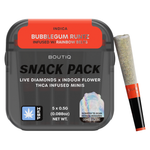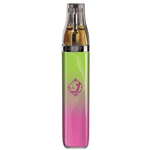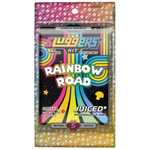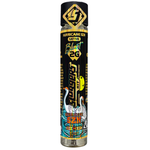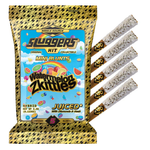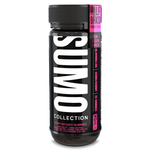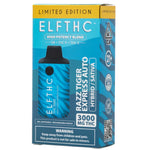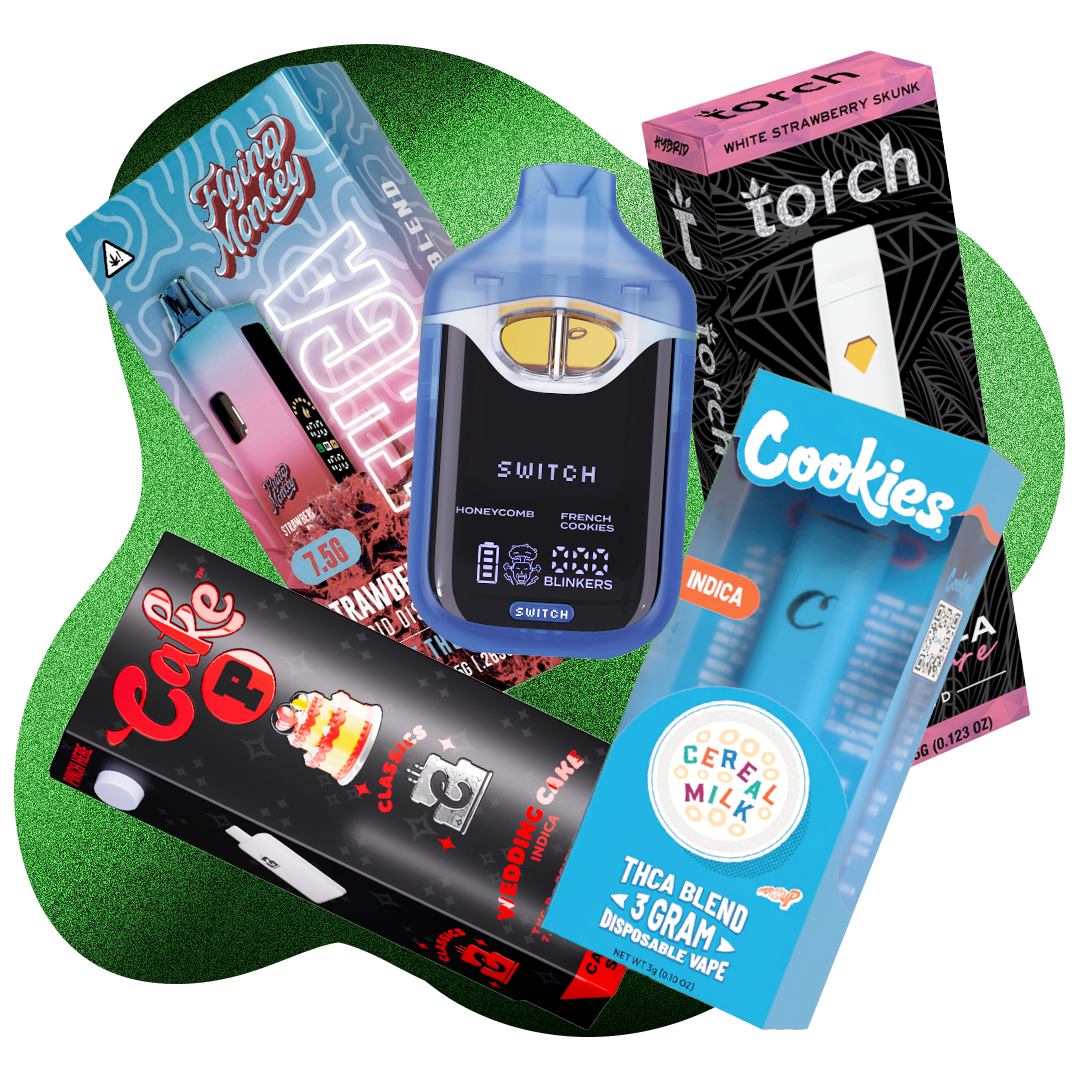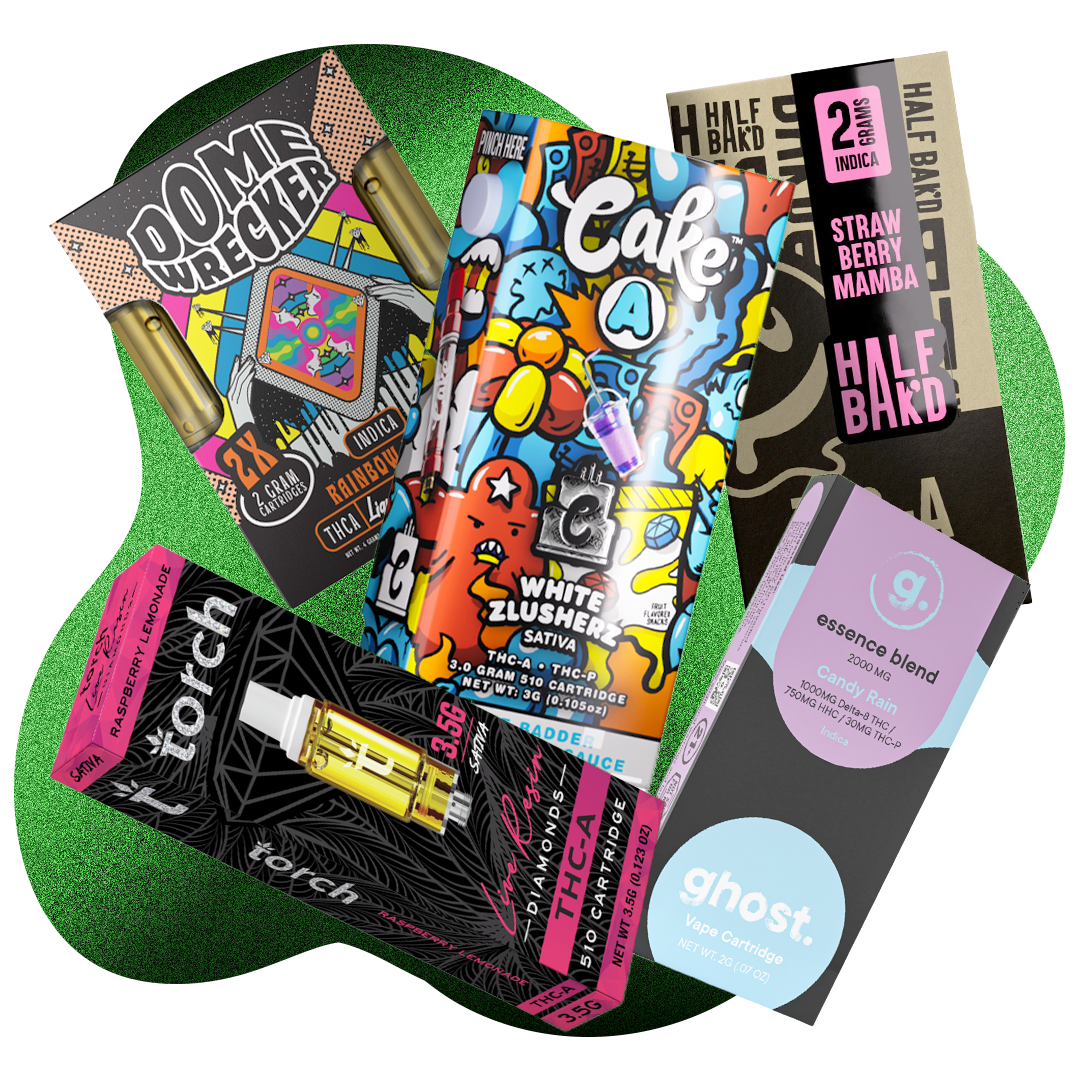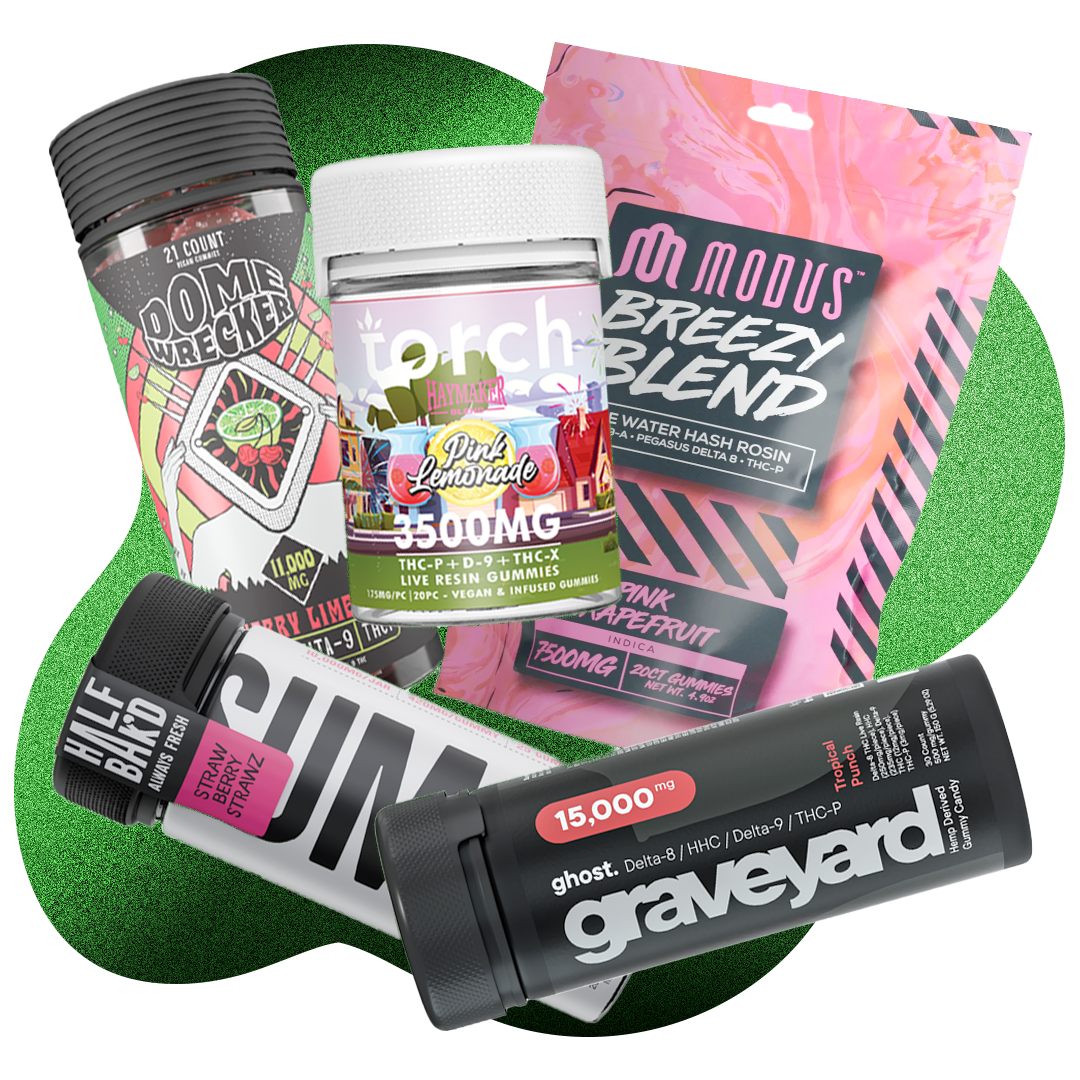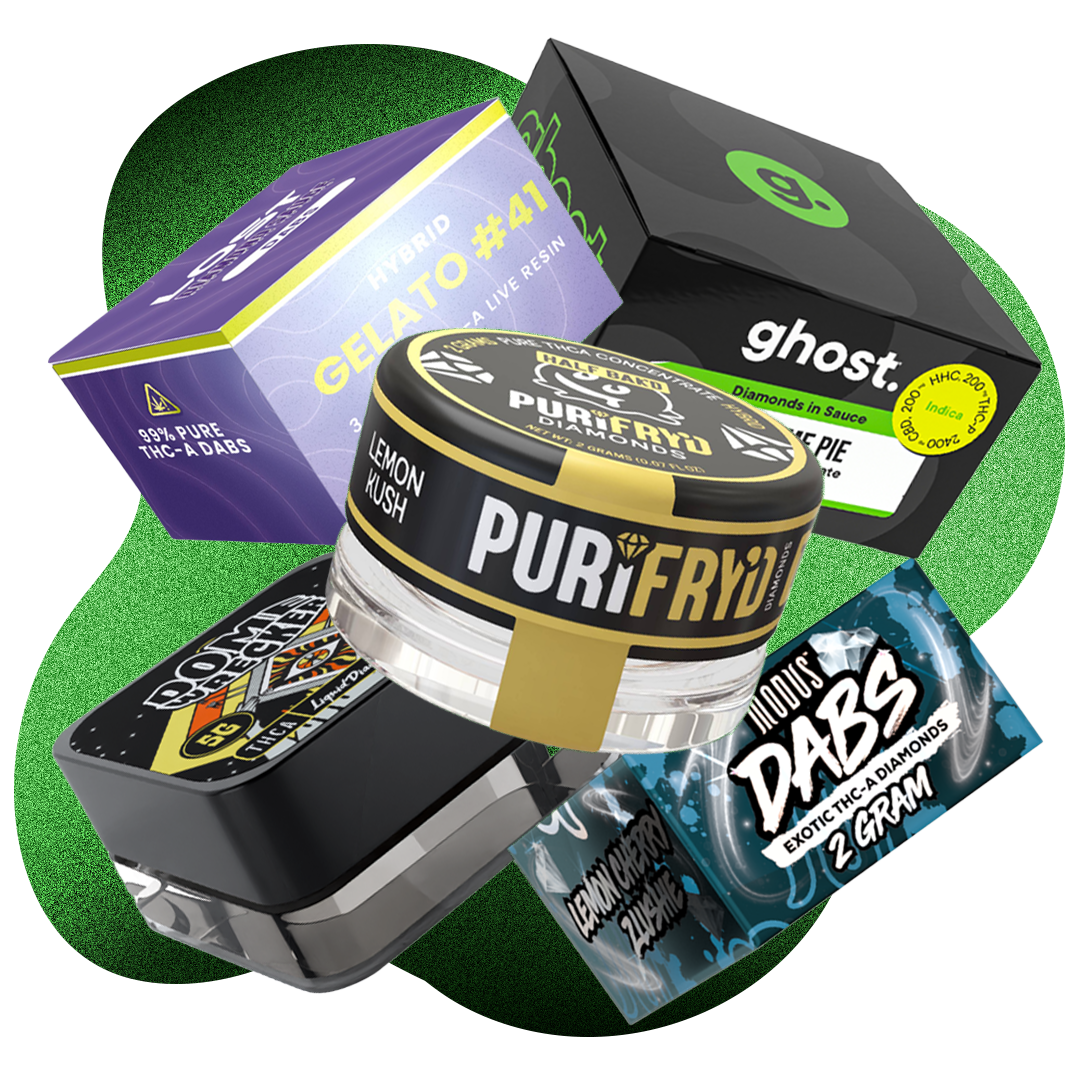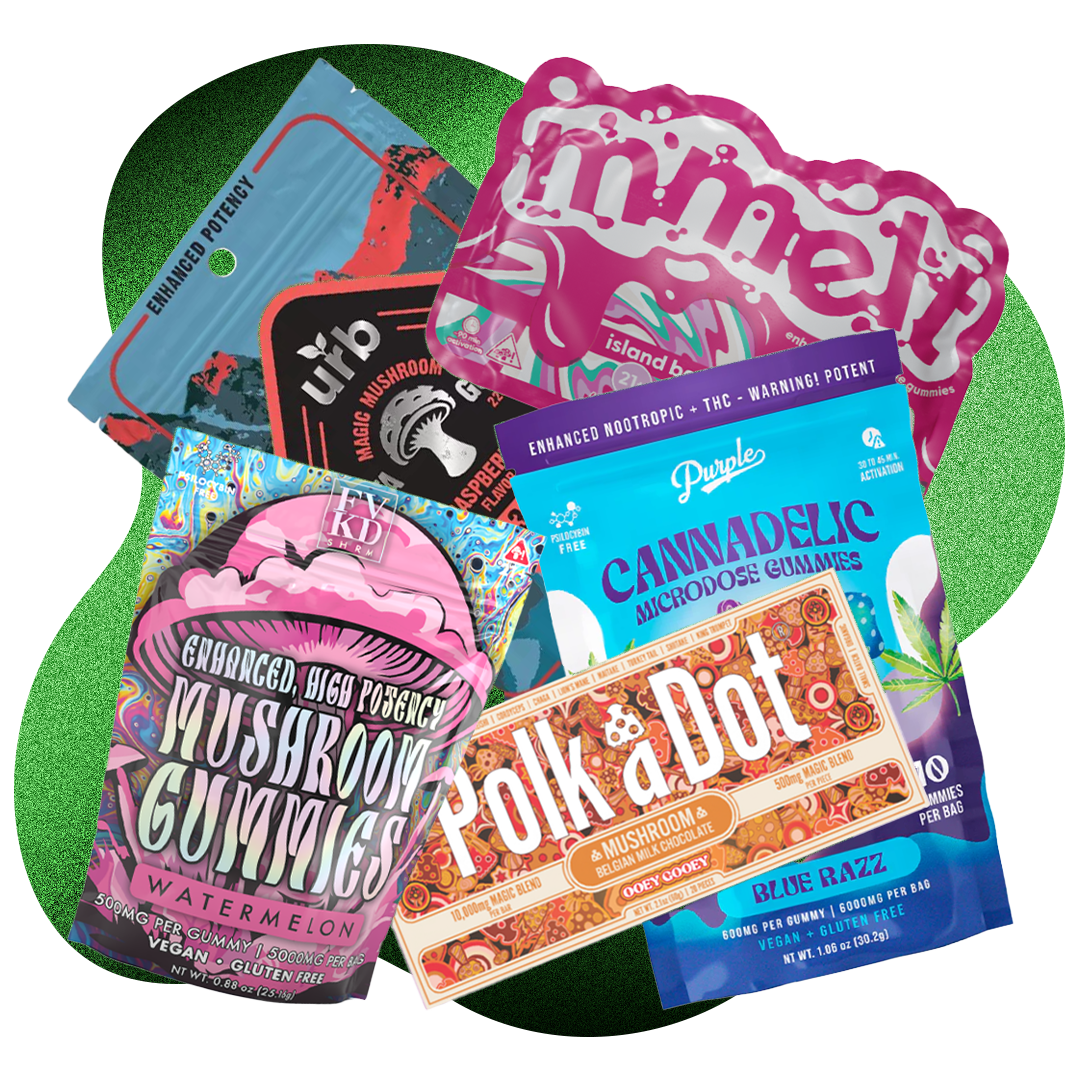Delta-8 tetrahydrocannabinol (Delta-8 THC or D8 THC) edibles have emerged as a prominent category within the cannabinoid market, attracting significant attention for their unique properties. These products, most commonly found in the form of gummies, offer a discreet and convenient method of consumption, distinguishing themselves from other cannabinoid delivery systems.
The appeal of Delta-8 edibles largely stems from the experience they purport to offer. Users frequently describe Delta-8 as providing a milder, clearer, and less anxiety-inducing experience compared to Delta-9 THC, the primary psychoactive compound in cannabis. This characteristic positions Delta-8 as an attractive option for individuals new to THC or those seeking a less intense psychoactive effect. The reported benefits, including relaxation and mood elevation, further contribute to its growing popularity.
However, the widespread marketing of Delta-8 as a "diet weed" or "weed light" presents a nuanced reality. While this branding emphasizes a milder psychoactive profile, the underlying production process reveals that Delta-8 is predominantly semi-synthetically produced from cannabidiol (CBD) derived from hemp. This chemical conversion, often unregulated, introduces potential safety considerations related to the manufacturing process and the presence of residual chemicals or contaminants. This duality between consumer perception of a natural, safer alternative and the semi-synthetic production process underscores the critical need for transparency in product sourcing and manufacturing, alongside robust third-party testing, to build and maintain consumer trust.
Note: These are general guidelines. Individual responses vary. Always consult a healthcare professional before use, especially if taking other medications.
Note: Individual factors such as metabolism, body weight, and tolerance can influence these times.
The Science Behind Delta-8 THC: A Deeper Dive
Delta-8 THC is a cannabinoid, a chemical compound naturally occurring in the Cannabis sativa plant. It is structurally an isomer of Delta-9 THC, meaning both compounds share the same chemical formula but possess a distinct arrangement of atoms. This subtle but significant structural difference lies in the position of a double bond: in Delta-8, it is located on the eighth carbon chain, whereas in Delta-9, it is on the ninth. This positional variance directly influences how each compound interacts with the body's receptors and, consequently, their psychoactive potency. While Delta-8 THC exists naturally in trace amounts within the cannabis plant, the concentrated Delta-8 products widely available today are typically synthesized from hemp-derived CBD. This process, known as isomerization, involves the use of chemical solvents and acids to convert CBD into Delta-8 THC.Delta-8 vs. Delta-9 THC vs. CBD: A Comparative Analysis
Understanding the distinctions between Delta-8 THC, Delta-9 THC, and CBD is crucial for informed consumption, particularly given their varying effects, legal statuses, and mechanisms of action.- Delta-9 THC: This is the primary psychoactive compound found in marijuana, renowned for producing a more intense "high." Its effects commonly include increased appetite, elation, and profound relaxation, though higher doses can sometimes induce paranoia or anxiety. Delta-9 THC has demonstrated strong evidence for therapeutic applications such as pain relief, alleviation of nausea and vomiting, and management of certain neurological disorders.
- Delta-8 THC: Delta-8 offers milder psychoactive effects compared to Delta-9, often described as a clearer experience with less propensity for anxiety or paranoia.4 Its reported effects include relaxation, mild euphoria, reduction of inflammation, mild pain relief, and assistance with insomnia. It may also stimulate appetite and potentially aid in seizure management.
- CBD (Cannabidiol): Unlike its THC counterparts, CBD is non-intoxicating, meaning it does not produce a "high" or altered mental state. It is widely utilized for stress management, inflammation support, anxiety reduction, and overall well-being. CBD is also recognized as a potent antioxidant.
| Compound | Psychoactive Effect | Potency (relative to D9) | Common Effects/Benefits | Potential Side Effects (at higher doses) | Drug Test Detection | Federal Legality (Hemp-derived) | Natural Occurrence in Plant | Primary Production Method for Products | Mechanism of Action |
| Delta-8 THC | Mildly psychoactive | ~50-75% of D9 | Relaxation, mild euphoria, pain/nausea relief, appetite stimulation, mental clarity | Drowsiness, dry mouth, dizziness, increased anxiety/paranoia (less common than D9), lethargy, hallucinations | Likely positive | Legal (with <0.3% D9 THC) | Trace amounts | Semi-synthesis from CBD | Partial agonist of CB1/CB2 |
| Delta-9 THC | Strongly psychoactive | High | Intense euphoria, strong relaxation, increased appetite, pain/nausea relief | Paranoia, anxiety, impaired coordination, increased heart rate, dizziness | Likely positive | Illegal (unless state-legal program) | Abundant | Direct extraction from cannabis | Full agonist of CB1/CB2 (more potent) |
| CBD (Cannabidiol) | Non-intoxicating | N/A | Stress relief, anti-inflammatory, mood support, general well-being | Fatigue, dry mouth, diarrhea, changes in appetite | Unlikely (isolate) / Possible (full/broad spectrum) | Legal | Abundant | Direct extraction from hemp | Indirect modulator of ECS, interacts with other receptors (TRPV1, PPARγ) |
How Delta-8 Interacts with Your Body (Mechanism of Action)
Delta-8 THC exerts its effects primarily by interacting with the body's endocannabinoid system (ECS). The ECS is a complex biological system involved in regulating a wide array of physiological processes, including mood, appetite, pain sensation, and memory. Within this system, Delta-8 binds to cannabinoid receptors, predominantly the CB1 receptors located in the central nervous system (brain and spinal cord), and to a lesser extent, the CB2 receptors, which are found mainly in the immune system and peripheral tissues. Delta-8 THC functions as a partial agonist of both CB1 and CB2 receptors, meaning it activates these receptors but with approximately half the potency of Delta-9 THC. This lower affinity for CB1 receptors is widely believed to be the reason behind its milder psychoactive effects compared to Delta-9 THC. Upon ingestion, Delta-8 THC undergoes metabolism in the liver. Hepatic cytochrome P450 enzymes, specifically CYP2C9 and CYP3A4, convert Delta-8 THC into 11-hydroxy-Δ8-tetrahydrocannabinol (11-OH-Δ8-THC). This metabolite is then further processed and eventually excreted from the body. This metabolic pathway closely mirrors that of Delta-9 THC. The fact that Delta-8 THC is metabolized by CYP3A4 enzymes carries significant implications for individuals taking other medications. Many common prescription drugs, including benzodiazepines, opioids, antidepressants, immunosuppressants, and medications for blood pressure and blood sugar, also rely on the CYP3A4 enzyme for their metabolism. If Delta-8 THC suppresses this enzyme, it can lead to a slower breakdown of these other medications. This interaction can result in either reduced effectiveness of the medication or, more dangerously, an accumulation of the drug in the body to potentially toxic levels. This creates a substantial, yet often overlooked, health risk for individuals on chronic prescription medications. This situation underscores the absolute necessity of consulting a healthcare professional before using Delta-8 THC, particularly for those with existing health conditions or who are currently taking other drugs. The current lack of comprehensive regulation further exacerbates this risk, as consumers may not receive adequate warnings about these critical interactions.Exploring the Benefits and Effects of Delta-8 Edibles
Delta-8 THC edibles are sought after not only for their mild psychoactive properties but also for a range of reported therapeutic benefits and a distinct user experience.Reported Therapeutic Benefits
Users of Delta-8 THC frequently report a sense of relaxation and mild euphoria. Beyond these mood-altering effects, Delta-8 is also associated with several potential therapeutic applications:- Nausea and Vomiting Relief: It may possess antiemetic properties, offering relief from nausea and vomiting.
- Pain Reduction: Delta-8 shows potential for pain reduction due to its analgesic properties.
- Anxiety and Stress Management: It can contribute to anxiety reduction (anxiolytic properties) and overall stress relief.
- Appetite Stimulation: Delta-8 may stimulate appetite, exhibiting orexigenic properties.
- Sleep Improvement: It can aid in improving sleep quality, either directly through its sedative effects or indirectly by addressing underlying issues such as anxiety that disrupt sleep.
- Neuroprotective Properties: Some preliminary studies suggest Delta-8 may possess neuroprotective qualities.
The Delta-8 Experience: What to Expect
The experience with Delta-8 THC is often characterized by a calm and relaxing "high," notably without the intensity that some individuals find overwhelming with Delta-9 THC. Common effects reported by users include a gentle sense of euphoria, heightened relaxation, and improved mental clarity.2 Unlike Delta-9, Delta-8 is less likely to induce paranoia or anxiety, allowing users to maintain a clear head and often remain productive. It is important to note that individual experiences can vary significantly based on factors such as dosage, personal tolerance, body chemistry, and the specific product consumed. The emphasis on therapeutic benefits like pain relief, anxiety reduction, and improved sleep, coupled with the description of a "milder" and "clearer" psychoactive effect, points to a significant user base interested in Delta-8 for wellness-oriented purposes rather than purely recreational intoxication. The focus on "mental clarity" and the ability to remain "productive" further suggests that many consumers are seeking functional benefits to enhance their well-being. This implies that Delta-8 edibles are often viewed as a tool for improved quality of life, rather than solely for their psychoactive properties. This perspective highlights the importance of positioning Delta-8 products within a broader wellness context, while still maintaining stringent warnings about their psychoactive nature and the necessity of responsible consumption.The Entourage Effect: Enhancing the Experience
The "entourage effect" is a compelling theory in cannabinoid science that posits a synergistic interaction among the various compounds present in the cannabis plant. This includes not only cannabinoids like Delta-8 THC and CBD but also terpenes, flavonoids, and other plant compounds. The theory suggests that when these compounds work together, they can collectively enhance the therapeutic effects of the plant and potentially mitigate some of the individual side effects that might occur if cannabinoids were used in isolation. Full-spectrum Delta-8 products, which retain a range of other beneficial cannabinoids and terpenes alongside Delta-8 THC, are believed to offer a more comprehensive and well-rounded experience compared to products containing only isolated Delta-8. Terpenes, which are responsible for the distinct aromas and flavors of different cannabis strains, are thought to play a particularly significant role in this synergistic effect, potentially influencing the overall therapeutic profile. While research on the entourage effect is ongoing, the concept supports the idea that the whole plant's compounds may offer greater benefits than individual extracts.Navigating Delta-8 Edible Dosage and Consumption
Determining the appropriate dosage for Delta-8 THC edibles is a highly individualized process, influenced by a multitude of factors, including body weight, metabolic rate, existing tolerance levels, and the specific effects an individual seeks to achieve.Finding Your Optimal Dose
For those new to Delta-8 THC, the cardinal rule is to "start low and go slow". This cautious approach allows individuals to gauge their reaction and gradually find their optimal dose without experiencing overwhelming effects. A recommended starting dose for beginners is typically between 2.5 and 5 mg of Delta-8 THC, which might equate to half a gummy or less, depending on the product's potency. Intermediate users may consider starting with 5-10 mg, while advanced users might begin with 10-20 mg. A general guideline for estimating a starting dose is approximately 0.05 mg per pound of body weight. For instance, an individual weighing 120 lbs might start with around 6 mg (120 x 0.05), while someone weighing 200 lbs might begin with 10 mg (200 x 0.05). Specific desired effects can also guide dosage: lower doses (around 0.05 mg per pound of body weight) are often suggested for relaxation, while 15-30 mg might be aimed for sleep improvement. For enhanced focus, adhering to the calculated weight-based doses is often recommended. It is crucial to monitor how the body responds to each dose and to increase gradually in small increments, such as 2.5 mg at a time, allowing sufficient time for effects to manifest before considering additional consumption. The challenge of inconsistent dosing in the Delta-8 market cannot be overstated. Despite the existence of general dosage guidelines, research repeatedly highlights that Delta-8 products often operate within an unregulated environment, leading to significant inconsistencies in potency. This means that the milligram content stated on a product label may not accurately reflect the actual Delta-8 concentration, or the presence of other cannabinoids or contaminants. This inherent variability directly undermines the ability to achieve precise dosing and significantly elevates the risk of accidental overconsumption. Consequently, the "start low and go slow" recommendation transitions from a mere suggestion to a critical safety imperative. This situation further underscores the absolute necessity of purchasing Delta-8 products exclusively from reputable brands that provide readily accessible and verifiable third-party lab testing results, typically in the form of Certificates of Analysis (COAs), to confirm actual potency and purity. Consumers must be educated to exercise skepticism towards products lacking transparent and verifiable lab results. Table: Delta-8 Edibles Dosage Guidelines by Experience Level & Weight| Experience Level | Body Weight Range | Recommended Starting Dose (mg) | Moderate Dose (mg) | High Dose (mg) | Waiting Period Before Redosing (Edibles) |
| First-time/Beginner | Under 100 lbs | 1-2.5 mg | 2.5-7.5 mg | 7.5-15 mg | 1-2 hours |
| 100-150 lbs | 2.5-5 mg | 5-10 mg | 10-20 mg | 1-2 hours | |
| 150-200 lbs | 5-7.5 mg | 7.5-15 mg | 15-30 mg | 1-2 hours | |
| Over 200 lbs | 7.5-10 mg | 10-20 mg | 20-40 mg | 1-2 hours | |
| Intermediate | All Weights | 5-10 mg | 10-20 mg | 20-40 mg | 1-2 hours |
| Advanced | All Weights | 10-20 mg | 20-40 mg | 40+ mg | 1-2 hours |
Onset and Duration of Effects
The time it takes for Delta-8 THC effects to manifest and how long they persist are significantly influenced by the method of consumption.- Edibles (Gummies, Capsules): Edibles, such as gummies and capsules, have a longer onset time because the Delta-8 THC must first be digested and then metabolized by the liver before entering the bloodstream. Effects typically begin within 30 to 90 minutes, sometimes extending to 1-2 hours. Once the effects kick in, they tend to be prolonged, often lasting for 4 to 8 hours or even longer, with the most pronounced effects usually felt within the first few hours.
- Vaping/Smoking: Inhalation methods, such as vaping or smoking Delta-8, offer a much faster onset of effects, usually within 5 to 15 minutes, as the cannabinoids are absorbed directly into the bloodstream via the lungs. However, the duration of these effects is considerably shorter, typically lasting only 2 to 3 hours.
- Tinctures (Sublingual): Delta-8 tinctures, administered sublingually (under the tongue), provide a quicker onset than edibles, usually within 15 to 30 minutes, and their effects generally last for 3 to 5 hours.
| Consumption Method | Onset Time | Duration of Effects | Notes |
| Edibles (Gummies, Capsules) | 30-90 minutes (up to 2 hours) | 4-8+ hours | Digestion and liver metabolism required; more intense body high |
| Tinctures (Sublingual) | 15-30 minutes | 3-5 hours | Absorbed via capillaries under the tongue; bypasses initial liver metabolism |
| Vaping/Smoking | 5-15 minutes | 2-3 hours | Direct absorption into lungs/bloodstream; faster but more fleeting effects |
Water-Soluble vs. Oil-Soluble Edibles
The traditional understanding of cannabinoid absorption notes that compounds like Delta-8 THC are naturally lipophilic, meaning they dissolve in fats. When consumed in oil-based forms, these cannabinoids are absorbed into the lymphatic system before eventually entering the bloodstream, resulting in a slower onset of effects but potentially a longer duration. A significant advancement in cannabinoid delivery is the development of water-soluble Delta-8 THC, often achieved through nano-emulsion technology. This process breaks down Delta-8 THC molecules into much smaller particles, which are then more easily absorbed directly into the bloodstream. The primary advantage of water-soluble forms is a dramatically faster onset of effects, typically within 5-10 minutes, a stark contrast to traditional oil-based edibles. Furthermore, water-soluble products often exhibit higher bioavailability, meaning a greater proportion of the compound is absorbed into the systemic circulation. This technology also enhances versatility, allowing Delta-8 to be easily dissolved into various foods or beverages without altering their taste or smell. While water-soluble Delta-8 offers a more predictable and rapid experience, which is desirable for many users, this technological advancement also introduces a crucial consideration. The faster onset and increased bioavailability mean that the effects will be felt more rapidly and potentially with greater intensity for a given stated dose. Therefore, for consumers, especially beginners, even greater caution is warranted with dosing water-soluble products. The principle of "start low, go slow" becomes even more critical to prevent overwhelming effects due to the quicker absorption. This innovation not only opens new avenues for product development, such as infused beverages, but also demands heightened consumer awareness regarding dosage adjustments for these more efficient delivery systems.Understanding the Risks: Side Effects, Interactions, and Safety Concerns
While Delta-8 THC is often perceived as a milder alternative to Delta-9, it is still a psychoactive substance with potential side effects, drug interactions, and significant safety concerns, particularly given the largely unregulated market.Common Side Effects of Delta-8 THC Edibles
Delta-8 THC, especially at higher doses, can induce various side effects, though they are generally considered less intense than those associated with Delta-9. Commonly reported side effects include:- Drowsiness/Fatigue: Many users experience sleepiness, making Delta-8 a popular choice for relaxation or sleep aid, but also a concern for daytime use.
- Dry Mouth: A frequently reported cannabinoid side effect.
- Dizziness or Lightheadedness: Can occur, particularly with higher doses or for new users.
- Increased Heart Rate or Palpitations: A cardiovascular effect that some individuals may experience.
- Anxiety, Paranoia, or Confusion: While less common than with Delta-9, these psychoactive effects are still possible, especially at elevated doses.
- Nausea or Vomiting: Paradoxically, while Delta-8 can alleviate nausea, it can also cause it in some individuals.
- Impaired Motor Skills or Coordination: Delta-8 can affect physical coordination and control.
- Lethargy or Hallucinations: More severe effects that can occur with excessive consumption.
- Red Eyes: A common visual indicator of cannabinoid use.
Potential Drug Interactions
Delta-8 THC has the potential to interact with various other substances, including prescription medications, over-the-counter drugs, and alcohol. The primary mechanism for these interactions involves cannabinoids, including Delta-8 THC, potentially suppressing the CYP3A4 enzyme. This enzyme is critical for the metabolism of a wide range of medications. When its activity is inhibited, the breakdown of these drugs can slow down, leading to reduced effectiveness of the medication or, more dangerously, an accumulation of the drug in the body to potentially toxic levels. Specific medication classes that warrant caution when combined with Delta-8 THC include:- Benzodiazepines, Opioids, and Antidepressants (SSRIs, SNRIs): Combining Delta-8 with these medications can lead to increased sedation, dizziness, and mood shifts. There is also a heightened risk of serotonin syndrome when combined with certain antidepressants.
- Stimulants (e.g., Adderall): Interactions can result in unpredictable effects on mood, focus, and heart rate. Delta-8's relaxing properties may counteract the stimulating effects of these medications, leading to inconsistent or heightened reactions. Both substances can also affect blood pressure and heart rate, potentially increasing cardiovascular risks.
- Blood Pressure Medications: Delta-8 THC can influence blood pressure levels, potentially increasing heart rate and blood pressure, which can affect cardiovascular function and increase health risks when combined with blood pressure medications.
- Blood Sugar Medications: Potential interactions have been noted.
- Antihistamines (e.g., Benadryl): Combining Delta-8 THC with antihistamines can significantly enhance sedative effects, leading to increased drowsiness, dizziness, and impaired motor functions.
| Medication Class | Potential Interaction/Effect | Mechanism of Interaction (if known) | Recommendation |
| Benzodiazepines, Opioids, Antidepressants (SSRIs, SNRIs) | Increased sedation, dizziness, mood shifts, serotonin syndrome risk (with antidepressants) | Suppression of CYP3A4 enzyme, affecting metabolism; influence on serotonin levels (with antidepressants) | Consult doctor; avoid combination unless advised |
| Stimulants (e.g., Adderall) | Unpredictable effects on mood, focus, heart rate; Delta-8's relaxing properties may counteract stimulating effects | Both substances can affect blood pressure/heart rate | Consult doctor; avoid combination unless advised |
| Blood Pressure Medications | Can affect cardiovascular function, increased heart rate and blood pressure | Influence on endocannabinoid system, affecting blood pressure regulation | Consult doctor; monitor closely |
| Blood Sugar Medications | Potential for interaction | Suppression of CYP3A4 enzyme | Consult doctor |
| Antihistamines (e.g., Benadryl) | Enhanced sedative effects, increased drowsiness, dizziness, impaired motor functions | Enhanced sedative properties | Avoid unless directed by healthcare provider |
The Unregulated Landscape: Contaminants and Inconsistent Potency
One of the most pressing issues surrounding Delta-8 THC is the pervasive lack of regulation and quality control within its market. This absence of oversight creates significant public health risks.- Contaminants: Due to inadequate manufacturing practices, which may involve the use of unsafe chemicals for the conversion of CBD to Delta-8 or for altering the product's color, Delta-8 products can contain harmful substances. These include residual solvents (such as heptane), pesticides, heavy metals (like cadmium, arsenic, lead, mercury, and copper), mold, yeast, and even bacteria like salmonella. A concerning 2021 study of Delta-8 vape pens revealed that none of the 27 products examined were accurately labeled, and 11 contained unlabeled contaminants. Without proper regulation, verifying the safety of Delta-8 products for consumption becomes exceedingly difficult, posing a direct risk to users.
- Inconsistent Potency: The actual concentration of Delta-8 THC in a product can deviate significantly from what is advertised on the label. The FDA has specifically raised concerns about the variability in Delta-8 concentrations across products. This inconsistency leads to unpredictable and potentially dangerous effects, as consumers may unknowingly consume a much higher or lower dose than intended.
- Synthetic Additives: Some products may also contain other synthetic cannabinoids or unlisted additives, further increasing the risk of adverse reactions.
Concerns Regarding Youth Use and Accidental Ingestion
A significant concern surrounding Delta-8 THC products is the increasing trend of consumption among adolescents and young people, particularly in the United States. A 2023 study indicated that 11.4% of U.S. 12th graders had used Delta-8 THC in the past year, with a notable 35.4% of those reporting use 10 or more times. A particularly alarming aspect is that Delta-8 products, especially gummies, are often manufactured with appealing flavors and shapes that closely resemble conventional candies. This, combined with the absence of a federal minimum age requirement for purchasing Delta-8 products and inadequate child-resistant packaging or clear labeling in an unregulated market, significantly elevates the risk of accidental ingestion by children. Cases of acute intoxication, some leading to severe clinical symptoms, have been reported in the juvenile population due to unwitting consumption of these highly concentrated edibles. Given Delta-8's chemical similarities to Delta-9 THC, there are substantial concerns about its potential long-term health risks for youth, including adverse effects on brain development, the potential for addiction, and behavioral problems. The design of Delta-8 edibles, particularly gummies, to resemble conventional candies, coupled with the lack of federal minimum age requirements and insufficient child-proof packaging or clear labeling in an unregulated market, directly contributes to a heightened risk of accidental ingestion by children. This causal chain leads to acute intoxication and potential long-term health risks for young individuals. This situation highlights a critical need for industry-wide best practices concerning packaging and labeling, including mandatory child-resistant containers and prominent, unambiguous warnings. It also underscores the necessity of public awareness campaigns targeting parents and caregivers, educating them about the dangers of storing these products where children can access them. This specific issue is a major driving force behind the increasing implementation of stricter regulations at the state level.Risk of Dependence and Withdrawal
Regular use of Delta-8 THC can lead to the development of tolerance, meaning that increasing amounts of the substance are required to achieve the same desired effects. This can, in turn, result in physical or psychological dependence. If an individual attempts to cease regular Delta-8 use, they may experience withdrawal symptoms, which can include irritability, restlessness, sleep disturbances, and anxiety. While Delta-8 is generally considered to be less addictive than Delta-9 THC , consistent and prolonged use can still lead to complications. Furthermore, for individuals with a history of substance addiction, any form of THC, including Delta-8, is generally not recommended, as it carries the risk of triggering a relapse.Ensuring Safety and Quality: The Role of Third-Party Lab Testing
Given the largely unregulated nature of the Delta-8 market, third-party lab testing stands as an indispensable safeguard for consumer safety and product transparency.Why COAs Matter
A Certificate of Analysis (COA) is a comprehensive lab test report issued by an independent, unbiased third-party laboratory. For consumers, a COA serves as the primary tool to verify the quality and safety of a Delta-8 product.- Purity: COAs confirm the absence of harmful contaminants that can arise from inadequate manufacturing practices. These include residual solvents (e.g., heptane), pesticides, heavy metals (such as cadmium, arsenic, lead, mercury, and copper), and biological contaminants like mold, yeast, or salmonella.9 This verification is crucial because unsafe chemicals and impurities from the semi-synthesis process can remain in the final product.
- Potency: COAs provide accurate concentrations of Delta-8 THC, as well as other cannabinoids present, such as Delta-9 THC, CBD, CBG, CBC, and CBN. This information is vital for consumers to make informed dosing decisions and to ensure that the product's actual content aligns with its label claims, addressing the issue of inconsistent potency in the market.
- Terpene Profile: While often an optional component, COAs can also detail the terpene profile of a product. This information is valuable for understanding a product's aroma, flavor, and its potential effects, particularly in the context of the entourage effect.
- Compliance: For states that have implemented specific regulations for Delta-8, COAs demonstrate adherence to legal limits for Delta-9 THC and total THC content.
How to Read a Certificate of Analysis
To effectively utilize a COA, consumers should examine several key sections:- Lab Information: Verify that the COA originates from an accredited, independent third-party laboratory, ensuring impartiality.
- Product Information: Cross-reference the product name and batch number on the COA with those on the purchased product to ensure the report corresponds to the specific item.
- Cannabinoid Profile: Locate the Delta-8 THC concentration (typically in mg/g or percentage) and confirm that the Delta-9 THC content is below the federal legal limit of 0.3% on a dry weight basis. Also, note the presence and concentrations of other cannabinoids.
- Contaminant Testing: Review the sections dedicated to heavy metals, pesticides, residual solvents, and microbial contaminants. It is essential that all these sections indicate a "PASS" status, signifying the product's safety.
- Date of Testing: Ensure the COA is recent and relevant to the specific batch of the product.
- QR Codes: Many reputable brands facilitate transparency by including QR codes on their product packaging that link directly to the corresponding COA.


